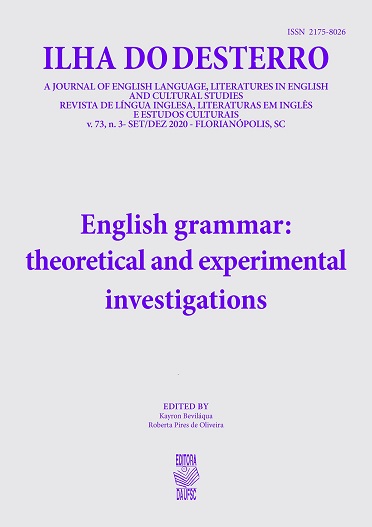A reticência repara violações de restrição de movimento da cabeça?
DOI:
https://doi.org/10.5007/2175-8026.2020v73n3p127Resumo
Usando dados em inglês, mostro que as violações da restrição de movimento da cabeça não podem ser reparadas por deleção e comparo esse resultado com casos de salvação e não-salvação por reticências da literatura anterior. Em seguida, considero duas fontes possíveis para essa falta de reparo. A primeira é considerar a restrição de movimento da cabeça como uma restrição derivacional, e a segunda é assimilá-la no princípio da categoria vazia (Chomsky 1986).
Referências
Baker, M. C., Aranovich, R., & Golluscio, L. A. (2005). Two Types of Syntactic Noun Incorporation: Noun Incorporation in Mapudungun and its Typological Implications. Language, 81(1), 138–176.
Barros, M., Elliott, P., & Thoms, G. (2014). There is no island repair.
Boeckx, C., & Lasnik, H. (2006). Intervention and Repair. Linguistic Inquiry, 37(1), 150–155.
Bošković, Ž. (2011). Rescue by PF Deletion, Traces as (Non)interveners, and the emphThat-Trace Effect. Linguistic Inquiry, 42(1), 1–44.
Chomsky, N. (1972). Some Empirical Issues in the Theory of Transformational Grammar. In P. S. Peters (Ed.), The Goals of Linguistic Theory (pp. 63–130). Prentice-Hall.
Chomsky, N. (1981). Lectures on government and binding. Foris Publications.
Chomsky, N. (1986). Barriers. MIT Press.
Chomsky, N. (1995). The minimalist program. MIT Press.
Chomsky, N. (2001). Derivation by Phase. In M. Kenstowicz (Ed.), Ken Hale: A Life in Linguistics (pp. 1–52). MIT Press.
Chung, S. (2006). Sluicing and the Lexicon: The Point of No Return. In R. T. Cover & Y. Kim (Eds.), Berkeley Linguistic Society 31 (pp. 73–91). UC, Berkeley.
Chung, S., Ladusaw, W., & McCloskey, J. (1995). Sluicing and Logical Form. Natural Language Semantics, 3, 1–44.
Fox, D., & Lasnik, H. (2003). Successive-cyclic movement and island repair: The difference between Sluicing and VP-ellipsis. Linguistic Inquiry, 34(1), 143–154.
Griffiths, J., & Lipták, A. (2014). Contrast and island sensitivity in clausal ellipsis. Syntax, 3, 39–52.
Hornstein, N., Lasnik, H., & Uriagereka, J. (n.d.). The dynamics of islands: Speculations on the locality of movement. Linguistic Analysis, 33, 149–175.
Lasnik, H. (1976). Remarks on Coreference. Linguistic Analysis, 2, 1–22.
Lasnik, H. (1995). Verbal morphology: Syntactic Structures meets the Minimalist Program. In H. Campos & P. Kempchinsky (Eds.), Evolution and Revolution in Linguistic Theory (pp. 251–275). Georgetown University Press.
Lasnik, H. (2000). Syntactic Structures Revisited: Contemporary Lectures on Classic Transformational Theory. MIT Press.
Lasnik, H. (2001). When can you save a structure by destroying it? In M. Kim & U. Strauss (Eds.), Proceedings of the North East Linguistic Society 31 (Vol. 2, pp. 301–320). GLSA.
Masaya, Y., Hunter, T., & Frazier, M. (2015). Parasitic Gaps Licensed by Elided Syntactic Structure. Natural Language and Linguistic Theory, 33(4), 1439–1471.
Mendes, G., & Nevins, A. (2020). Salvation and non-salvation of defectiveness under ellipsis.
Merchant, J. (1999). The syntax of silence: Sluicing, islands, and identity in ellipsis [Doctoral dissertation]. University of California.
Merchant, J. (2008). Variable island repair under ellipsis. In K. Johnson (Ed.), Topics in Ellipsis (pp. 132–153). Cambridge University Press.
Merchant, J. (2013). Voice and Ellipsis. Linguistic Inquiry, 44(1), 77–108.
Merchant, J., & Craenenbroeck, J. van. (2013). Ellipsis phenomena. In M. den Dikken (Ed.), The Cambridge Handbook of Generative Syntax (pp. 701–745). Cambridge University Press.
Nakao, C. (2009). Island repair and non-repair by PF strategies [Doctoral dissertation]. University of Maryland.
Perlmutter, D. (1971). Deep and Surface Structure constraints in Syntax. Holt, Rinehart and Winston.
Richards, N. W., III. (1997). What moves where when in which language? [PhD Thesis]. Massachusetts Institute of Technology.
Rizzi, L. (1990). Relativized minimality. MIT Press.
Ross, J. R. (1969). Guess who? In R. I. Binnick, A. Davison, G. M. Green, & J. L. Morgan (Eds.), Chicago Linguistics Society (pp. 252–286).
Rottman, I., & Yoshida, M. (2013). Sluicing, Idioms and Island Repair. Linguistic Inquiry, 44(4), 651–668.
Rudin, C. (1988). On multiple questions and multiple wh-fronting. Natural Language and Linguistic Theory, 6, 445–501.
Sigurðsson, H. Á. (2002). To be an oblique subject: Russian vs. Icelandic. Natural Language and Linguistic Theory, 20(4), 691–724.
Travis, L. (1984). Parameters and Effects of Word Order Variation [PhD Thesis]. Massachusetts Institute of Technology.
Wood, J., Barros, M., & Sigurdson, E. F. (2019). Case mismatching in Icelandic clausal ellipsis. Journal of Linguistic.
Downloads
Publicado
Edição
Seção
Licença
Copyright (c) 2020 Gesoel Mendes

Este trabalho está licenciado sob uma licença Creative Commons Attribution 4.0 International License.
A revista Ilha do Desterro publica artigos e resenhas inéditos, referentes as áreas de Inglês, Literaturas em Língua Inglesa e Estudos Culturais. Publica volumes mistos e/ou temáticos, com artigos e resenhas em inglês e português.
Autores mantém os direitos autorais e concedem à revista o direito de primeira publicação, com o trabalho simultaneamente licenciado sob a Licença Creative Commons Attribution que permite o compartilhamento do trabalho com reconhecimento da autoria e publicação inicial nesta revista.

This work is licensed under a Creative Commons Attribution 4.0 International License.



